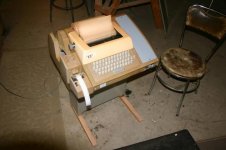Mike_Z
Veteran Member
Well, it's been a few months since I've even looked at the PDP8E. Last December I was fighting two stuck bits in the major registers. I fixed one. There was a bad D flip flop in the MB register. But the other was driving me nuts. I kept chasing in circles looking for the problem. Well, I decided that I needed a break. In fact I drove down to see Jack Rubin. He and some friends were going on a rescue mission, so I went along. They picked up a bunch of older computer 'stuff'. I got a Teletype ASR 33 TZ. Spent the last two months cleaning, oiling, fixing, etc, and I got the thing to work. I wanted it to connect up to the PDP8, but since it wasn't working, I connected the TTY to one of my homemade CP/M machines with good results. I still have a few bugs to iron out, like the control key doesn't work right, but I think that is a minor fix, when I get some time.


Anyway, I have gotten back to the PDP8E and have gotten the problem repaired. There was a problem with one of the input MUX bits, on the input side of the adders. So, I've loaded the incrementing accumulator program,
7001
2101
5001
5000
And it has worked many times over the past three days. So, my next project is to repair and install a 8650 UART board. But.... before I go there, I'd like to test the PDP8E a little more to be sure it is fully functional. I'm looking for a couple more short test programs that I can key in from the front panel to run for a few days to check out all the functions of the machine. And to help me become a little more familiar with the use of the front panel. Can anyone point me in the right direction? Thanks Mike


Anyway, I have gotten back to the PDP8E and have gotten the problem repaired. There was a problem with one of the input MUX bits, on the input side of the adders. So, I've loaded the incrementing accumulator program,
7001
2101
5001
5000
And it has worked many times over the past three days. So, my next project is to repair and install a 8650 UART board. But.... before I go there, I'd like to test the PDP8E a little more to be sure it is fully functional. I'm looking for a couple more short test programs that I can key in from the front panel to run for a few days to check out all the functions of the machine. And to help me become a little more familiar with the use of the front panel. Can anyone point me in the right direction? Thanks Mike
